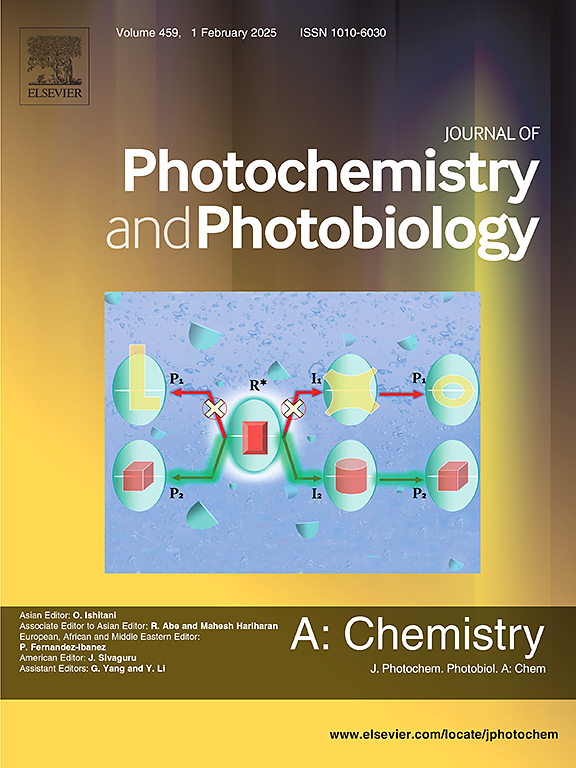光动力治疗用腙取代BODIPY衍生物的设计与合成
IF 4.1
3区 化学
Q2 CHEMISTRY, PHYSICAL
Journal of Photochemistry and Photobiology A-chemistry
Pub Date : 2025-06-22
DOI:10.1016/j.jphotochem.2025.116592
引用次数: 0
摘要
在本研究中,我们通过2位和3位的腙键取代了BODIPY染料,形成了新的构建块,并研究了它们在ph控制光敏剂单元释放中的效果,用于靶向光动力治疗癌症。两种不同的单线态氧猝灭机制,CN键异构化和Förster共振能量转移,研究了两种不同的结构,A和b。在这项工作的一部分,研究了先前发现的CN键直接附着/脱离对1O2产生的影响,使用更长的波长吸收化合物,A。但在本研究中,这是第一次成功实现。研究了新型腙类BODIPY衍生物的设计合成及其在低pH条件下的光动力活性。对于化合物A和B,证明了通过不同比例的异构化和FRET机制,使用CN键取代策略可以成功地减少单线态氧的产生。而相应的腙键的裂解可以将结构转化为细胞毒性的产生o2的单位,用于靶向癌症治疗。在低pH调节培养基的光细胞毒性研究中,化合物A (250 nM, MCF-7细胞)和B (500 nM, HeLa细胞)在pH 6.8下有效解锁了1O2的产生。本文章由计算机程序翻译,如有差异,请以英文原文为准。

Design and synthesis of hydrazone-substituted BODIPY derivatives for photodynamic therapy
In this study, we substituted BODIPY dyes through hydrazone bonds at their 2- and 3-positions, formed new building blocks, and studied their efficacy in the pH-controlled release of photosensitizer units for targeted photodynamic therapy in cancer treatment. Two different singlet oxygen quenching mechanisms, C![]() N bond isomerization and Förster resonance energy transfer, were studied in two distinct structures, A and B. In one part of this work, the previously discovered direct C
N bond isomerization and Förster resonance energy transfer, were studied in two distinct structures, A and B. In one part of this work, the previously discovered direct C![]() N bond attachment/detachment effect on 1O2 production was studied using a longer wavelength-absorbing compound, A. The synthesis of styryl-substituted hydrazone-BODIPY compounds (e.g. compound A) is challenging, but this was successfully achieved for the first time in the current study. The design and synthesis of new hydrazone BODIPY derivatives and their activation capabilities at low pH for targeted photodynamic action were elucidated. With compounds A and B, it was demonstrated that singlet oxygen production could be successfully minimized using a C
N bond attachment/detachment effect on 1O2 production was studied using a longer wavelength-absorbing compound, A. The synthesis of styryl-substituted hydrazone-BODIPY compounds (e.g. compound A) is challenging, but this was successfully achieved for the first time in the current study. The design and synthesis of new hydrazone BODIPY derivatives and their activation capabilities at low pH for targeted photodynamic action were elucidated. With compounds A and B, it was demonstrated that singlet oxygen production could be successfully minimized using a C![]() N bond substitution strategy through both isomerization and FRET mechanisms in varying proportions. And the cleavage of the corresponding hydrazone bonds can convert the structures into cytotoxic 1O2-producing units for targeted cancer therapy. In the photocytotoxicity studies with low-pH-adjusted media, 1O2 production was unlocked effectively with compound A (250 nM, with MCF-7 cells) and B (500 nM, with HeLa cells) at pH 6.8.
N bond substitution strategy through both isomerization and FRET mechanisms in varying proportions. And the cleavage of the corresponding hydrazone bonds can convert the structures into cytotoxic 1O2-producing units for targeted cancer therapy. In the photocytotoxicity studies with low-pH-adjusted media, 1O2 production was unlocked effectively with compound A (250 nM, with MCF-7 cells) and B (500 nM, with HeLa cells) at pH 6.8.
求助全文
通过发布文献求助,成功后即可免费获取论文全文。
去求助
来源期刊
CiteScore
7.90
自引率
7.00%
发文量
580
审稿时长
48 days
期刊介绍:
JPPA publishes the results of fundamental studies on all aspects of chemical phenomena induced by interactions between light and molecules/matter of all kinds.
All systems capable of being described at the molecular or integrated multimolecular level are appropriate for the journal. This includes all molecular chemical species as well as biomolecular, supramolecular, polymer and other macromolecular systems, as well as solid state photochemistry. In addition, the journal publishes studies of semiconductor and other photoactive organic and inorganic materials, photocatalysis (organic, inorganic, supramolecular and superconductor).
The scope includes condensed and gas phase photochemistry, as well as synchrotron radiation chemistry. A broad range of processes and techniques in photochemistry are covered such as light induced energy, electron and proton transfer; nonlinear photochemical behavior; mechanistic investigation of photochemical reactions and identification of the products of photochemical reactions; quantum yield determinations and measurements of rate constants for primary and secondary photochemical processes; steady-state and time-resolved emission, ultrafast spectroscopic methods, single molecule spectroscopy, time resolved X-ray diffraction, luminescence microscopy, and scattering spectroscopy applied to photochemistry. Papers in emerging and applied areas such as luminescent sensors, electroluminescence, solar energy conversion, atmospheric photochemistry, environmental remediation, and related photocatalytic chemistry are also welcome.

 求助内容:
求助内容: 应助结果提醒方式:
应助结果提醒方式:


